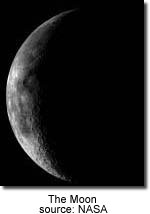|
How
to Photograph This Month's Lunar Eclipse
|
Reprinted
with permission from the New
York Institute of Photography.
01/06/2000
 On
the night of January 20, a total lunar eclipse will be visible across
all of America. While lunar eclipses don't elicit the excitement
of a solar eclipse among many devotees of astronomy, it's still
a great celestial event to watch. "A lunar eclipse is also a great
opportunity for photography," explains Chuck DeLaney, Dean of the
New York Institute of Photography. "Unlike a solar eclipse, photographing
the moon is easy and doesn't require complicated filters and excessive
precautions. So why not get out in the night air and try your hand
at astrophotography?" On
the night of January 20, a total lunar eclipse will be visible across
all of America. While lunar eclipses don't elicit the excitement
of a solar eclipse among many devotees of astronomy, it's still
a great celestial event to watch. "A lunar eclipse is also a great
opportunity for photography," explains Chuck DeLaney, Dean of the
New York Institute of Photography. "Unlike a solar eclipse, photographing
the moon is easy and doesn't require complicated filters and excessive
precautions. So why not get out in the night air and try your hand
at astrophotography?"
On
the New York Institute of Photography's Website this month there
is a comprehensive article on how to photograph both a full moon
and the moon during a lunar eclipse. According to NYI, once the
moon enters totality (which will be at 11:04pm in New York City
and three hours earlier in San Francisco) put your camera on manual
exposure. An exposure of 1 second at f/2.8 using ISO 400 speed film
is a good starting place. NYI suggests that you'll need a tripod
to steady your camera and you'll be wise to "bracket" your exposure
by using a variety of exposure combinations to put different amounts
of light on the film.
You
don't need a monster telephoto lens to record the eclipse. While
a 300mm lens with a tele-extender is a great tool for dramatic close-ups,
you can also use a shorter lens and include some scenery in the
frame. For example, a tree in silhouette can make a dramatic addition
to an eclipse photo. If you live in a city, you may be able to include
the skyline in your photo. NYI suggests that you study various outdoor
locations for a night or two before the eclipse to decide how to
make the most effective composition with your equipment, the moon's
position, and the terrain in your neighborhood.
For
a complete article on photographing the moon, along with information
about the times of moon rise, the start of the eclipse and totality
in your area, visit the New York Institute of Photography website.
| Total
Lunar Eclipse Milestones for January 20, 2000 |
| Milestone
Event |
GMT |
EST |
CST
|
MST
|
PST |
| Partial
Eclipse Begins: |
03:01
AM* |
10:01
PM |
09:01
PM |
08:01
PM |
07:01
PM |
| Total
Eclipse Begins: |
04:05
AM* |
11:05
PM |
10:05
PM |
09:05
PM |
08:05
PM |
| Mid-Eclipse:
|
04:44
AM* |
11:44
PM |
10:44
PM |
09:44
PM |
08:44
PM |
| Total
Eclipse Ends: |
05:22
AM* |
12:22
AM* |
11:22
PM |
10:22
PM |
09:22
PM |
| Partial
Eclipse Ends: |
06:25
AM* |
01:25
AM* |
12:25
AM* |
11:25
PM |
10:25
PM |
|
* Event occurs on morning of January 21, 2000
GST
- Greenwich Mean Time
EST - Eastern Standard Time
CST - Central Standard Time
MST - Mountain Standard Time
PST - Pacific Standard Time
|
Various
other links with examples of eclipse photography:
 Fred
Espenak's Eclipse Site
Fred
Espenak's Eclipse Site
 Dr.
Dale Ireland's Lunar Eclipse Site
Dr.
Dale Ireland's Lunar Eclipse Site
 Eclipse
Chaser
Eclipse
Chaser
<back
to articles>
|